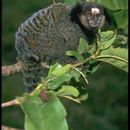en
names in breadcrumbs


The communication of black-pencilled marmosets has not been fully studied, however, it is believed that they communicate mostly through vocalizations. They appear to have predator-specific cries when they are threatened and have many vocalizations in addition to predator warnings. Black-pencilled marmosets also use scent marking, though it is unclear whether this is a form of communication, as many different family groups simply ignore the markings that another family group has left.
Communication Channels: acoustic ; chemical
Other Communication Modes: scent marks
Perception Channels: visual ; tactile ; acoustic ; chemical
Black-pencilled marmosets have no special status with the IUCN Red List or the Unites States Endangered Species Act List. They are listed in Appendix II of CITES and are not currently considered an endangered or threatened species.
US Federal List: no special status
CITES: appendix ii
IUCN Red List of Threatened Species: least concern
There are no known adverse affects of black-pencilled marmosets on humans.
Black-pencilled marmosets are considered highly valuable and exotic pets. They are also used often in zoo exhibits as well as many different types of scientific studies.
Positive Impacts: pet trade ; research and education
Black-pencilled marmosets are mutualists with many tree species, dispersing seeds of the fruit that they consume. They also act as parasites of other species of trees because they create sores in the trees in order to extract sap, while not positively affecting the tree in any way. They also serve as a source of prey for many larger animal species that reside in the forests, including large birds of prey, snakes, and wild cats.
Ecosystem Impact: disperses seeds
Species Used as Host:
Mutualist Species:
Black-pencilled marmosets commonly feed on tree sap. During food shortages or droughts their diet also includes fruit and insects, and they have even been known to eat various arthropods, molluscs, and small vertebrates.
Animal Foods: insects; terrestrial non-insect arthropods; mollusks
Plant Foods: fruit; sap or other plant fluids
Primary Diet: herbivore (Eats sap or other plant foods)
Black-pencilled marmosets are found in the Neo-tropical gallery forests of the Brazilian Central Plateau. They live along the Brazillian coast ranging from Bahia to Sao Paulo, and as far inland as Goias, between 14 and 17 degrees S.
Biogeographic Regions: neotropical (Native )
Black-pencilled marmosets live in rainforests, usually residing high in the trees, under the canopy. Marmosets have rarely been observed at or near ground level.
Habitat Regions: tropical ; terrestrial
Terrestrial Biomes: rainforest
The life-span of a wild black-pencilled marmoset is unknown, however the average lifespan in captivity is 15 years.
Average lifespan
Status: captivity: 15 years.
Average lifespan
Status: captivity: 15.4 years.
Black-pencilled marmosets typically have some sparse white hairs on their faces, with a dark brown or black head. Their upper body and limbs are gray and their rump is usually black. The marmosets' undersides are black with a gray abdomen. Their tail is ringed with black and white and is not prehensile, but is used for balance. They are characterized by the black tufts around their ears. Black-pencilled marmosets do not have an opposable thumb and their nails tend to have a claw-like appearance.
Average mass: 454 g.
Range length: 22.86 to 27.94 cm.
Other Physical Features: endothermic ; heterothermic ; homoiothermic; bilateral symmetry
Sexual Dimorphism: male larger
Average mass: 307 g.
Black-pencilled marmosets are vulnerable to a wide range of both terrestrial and aerial predators. Aerial predators, large raptors, are considered the marmosets greatest threat, but they are also preyed upon by a variety of snakes and wild cats. Black-pencilled marmosets use a series of predator-specific vocalizations as well as visual scanning in their antipredation strategies.
Known Predators:
Black-pencilled marmosets are monogamous and typically live in family groups which include the reproducing couple and their offspring.
Mating System: monogamous
Black-pencilled marmosets breed twice a year and produce between 1 and 4 offspring, however they generally have twins. The gestation period is 150 days and offspring wean at about 8 weeks. The marmosets reach sexual maturity at approximately 18 months old. However, they typically mate very late.
Breeding interval: Black-pencilled marmosets usually breed twice a year
Range number of offspring: 1 to 4.
Average number of offspring: 2, twins.
Average gestation period: 150 days.
Average weaning age: 8 weeks.
Range age at sexual or reproductive maturity (female): 13 to 20 months.
Average age at sexual or reproductive maturity (female): 18 months.
Range age at sexual or reproductive maturity (male): 13 to 20 months.
Average age at sexual or reproductive maturity (male): 18 months.
Key Reproductive Features: seasonal breeding ; gonochoric/gonochoristic/dioecious (sexes separate); sexual ; fertilization ; viviparous
Average number of offspring: 2.
There is considerable parental investment by both parents; infants are extremely dependent on their parents. The offspring are raised with the aid of other juvenile siblings. Offspring are weaned at 8 weeks and then taught to search for food.
Parental Investment: pre-fertilization (Provisioning, Protecting: Female); pre-hatching/birth (Provisioning: Female, Protecting: Female); pre-weaning/fledging (Provisioning: Male, Female, Protecting: Male, Female); pre-independence (Provisioning: Male, Female, Protecting: Male, Female); post-independence association with parents; extended period of juvenile learning; inherits maternal/paternal territory